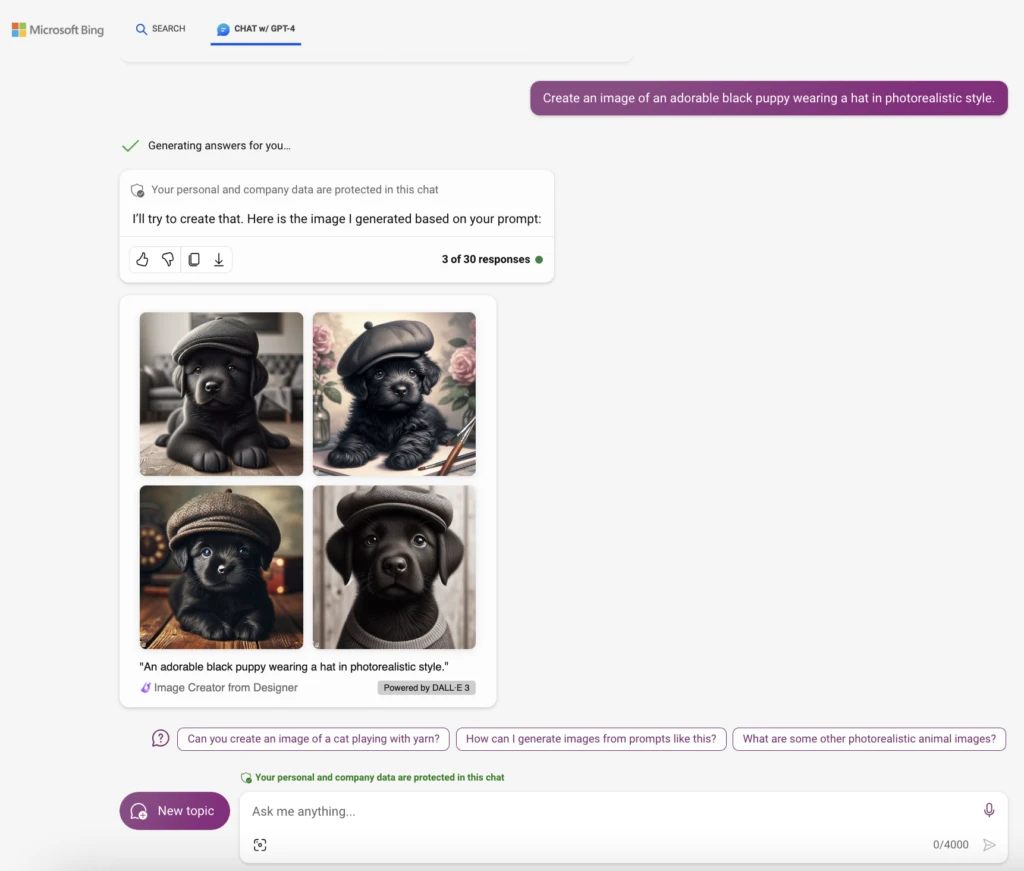How to access Microsoft Copilot 365
Go to copilot.microsoft.com and log in with your SPU Account Credentials.
You’ll see a page that shows example prompts and a text box at the bottom of the page. Type your prompt into the chat window or click on one of the prompts to see what Copilot can do!
Review the sources linked at the bottom by “Learn more.” You can fact-check the information provided or dive deeper into a topic by accessing the original articles, studies, or reports. Below is an example of what you might see in Copilot after submitting your query:
Review the response to make sure the output is what you want and accurate.
To get the most out of Copilot, you can keep the conversation going by following up on your prompts. This helps you collaborate with Copilot to gain more useful, tailored responses.
You can also give feedback to Copilot based on the quality of its responses to help the AI learn and match your preferences.
How to write a prompt for AI
To effectively guide generative AI, you want to give it clear and concise instructions, known as prompts. A well-crafted prompt enhances the generative AI’s output in the quality, relevance, and diversity. A good prompt should be clear, specific, and aligned with the goal of the generation task. A bad prompt can lead to ambiguous, irrelevant, or biased output. To get the best response from Copilot, consider the following tips:
Define clear objectives. Determine the main goal of the prompt and the role AI should take; have a clear vision of the end goal.
Be specific. Chat experiences operate best when given detailed instructions. For instance, “best towns to stop in along Route 66” is clearer than “towns along Route 66.”
Structure the prompt. Break complex tasks into smaller parts. Instead of asking the AI to draft an entire paper or article, request an outline, then delve into specific sections.
Iterate and refine. The first response from AI might not always align perfectly with expectations. Don’t hesitate to rephrase the prompt, ask follow-up questions, or provide more context based on the initial output.
Combine expertise. Use AI as a tool to enhance and streamline work but remember to overlay its suggestions with your expertise.
AI can suggest content, but you decide the best way to edit and present the content generated.
Create images from text with Copilot
You can use Image Creator from Designer in Copilot to create personalized, engaging visuals for all sorts of lessons or topics. You can type in a description of an image, provide additional context like location or activity, and choose an art style. Image Creator generates an image straight from your imagination. Prompts can begin with “draw an image” or “create an image.”
Get started in Copilot prompting “create an image…”
Then build out your prompt with adjective + noun + verb + style.
Click on your favorite image to open the result in a new tab and save the image.
An example would be “Create an image of an adorable black puppy wearing a hat in photorealistic style.”
An example of Copilot creating an image of a black dog wearing a hat in a photorealistic style, based on text descriptions.
Privacy and University Data
This tool is our recommended Generative AI tool as Microsoft won’t use what you enter into Copilot to train its system or share it with others. It also follows university data protection policies. Logging in with your SPU Account enables commercial data protection.
“Copilot provides commercial data protection and delivers a secure AI-powered chat service for educational institutions. This means user and organizational data are protected, chat prompts and responses in Copilot are not saved, Microsoft has no eyes-on access to them, and they aren’t used to train the underlying large language models. Additionally, our Customer Copyright Commitment means education customers can be confident using our services and the output they generate without worrying about copyright claims.“
Look for the shield icon in the top right-hand corner ensures your data is protected.
Additional Resources
https://learn.microsoft.com/en-us/copilot/microsoft-365/microsoft-365-copilot-overview



